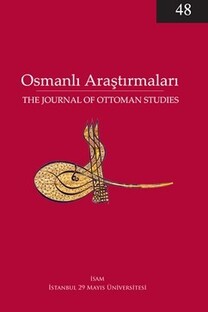Osmanlı Biladü’ş-Şamı’nda Yaşamış Olan 18. Yüzyıl Vakanüvislerinin Mekân Tahayyülleri
Bu makalede 18. yüzyıl Osmanlı Levant’ı/Biladü’ş-Şam’ından (günümüz Suriye,
Lübnan, Ürdün, İsrail ve Filistin’den) yedi vakanüvisin küresel mekân tahayyüleri
incelenmektedir. Farklı sosyal, dinî ve meslekî kökenlerden gelen söz konusu vakanüvisler, Biladü’ş-Şam’ın Arapça konuşan ahalisinden olmaları hasebiyle ortak bir kimlik
altında birleşseler de, Osmanlılıkla olan alakalarının da bilincindeydiler. Bu çalışmada,
vakanüvislerin kökenlerindeki ortaklıklar ve farklılıklar göz önüne alınarak her bir yazarın mekânsal tahayyülündeki “gerilimler” incelenmiştir. Bu doğrultuda, yazarların
tahayyüllerindeki dünya, grafiklere ve haritalara aktarılıp karşılaştırılarak, farklılık
gösteren ve birbiriye örtüşen coğrafî kimlikler görselleştirilmiştir. Devletlerin sınır
temelli kimliklerin inşasında çok az dahlinin olduğu ulus-öncesi bir çağda, Biladü’şŞamlı Osmanlıların aynı dünyada yaşayıp yaşamadığı sorusuna cevap aranmıştır.
Anahtar Kelimeler:
18. yüzyılda Osmanlı Biladü’ş-Şam’ı, Arapça Kronikler, Ulema Olmayan Tarihçiler, Mekân Tahayyülü, Bölgesel Kimlik, Görselleştirilmiş Mekân Algıları
In Other Worlds? Mapping Out the Spatial Imaginaries of 18th-Century Chroniclers from the Ottoman Levant (Bilād al-Shām)
This essay is about the global spatial imaginaries of seven chroniclers from
the Ottoman Levant (Bilād al-Shām/Syria and Palestine) in the eighteenth century.
While being unified in an Arabic-speaking Levantine identity, on the one hand, and
conscious of their Ottoman affiliation, on the other, the authors came from decidedly
different social, religious, and occupational backgrounds. Given the unity and diversity of the backgrounds of the authors, this essay examines the consequent tensions
found in each author’s spatial vision. By plotting and juxtaposing these authors’ horizons into maps and graphs, both the differing and overlapping concepts of geographical identities are visualized. In a pre-national age, when the state’s intervention in
creating a territory-bounded identity was minimal, did eighteenth-century Ottoman
Levantines live in the same world?
Keywords:
18th-Century Ottoman Levant, Arabic chronicles, non-scholarly historians, spatial imaginary, geographical identity, visualized worldviews,
___
- Bibliography Unpublished Manuscripts Ibn Budayr al-Ģallāq, Shihāb al-Dīn Aģmad, Ģawādith Dimashq al-Shām al-yawmiyya min sanat 1154 ilā sanat 1176, MS Chester Beatty, Arabic 3551/2, Dublin. Published Works al-‘Abd, Ģasan Āghā: Tārīkh Ģasan Āghā al-‘Abd: Ģawādith Bilād al-Shām wa al-Imbarašūriyya al-‘Uthmāniyya, ed. Yūsuf Nu‘aysa, Damascus: Dār Dimashq li-al-Šibā‘a wa al-Nashr, 1986. al-Amīn, al-Sayyid Muģsin: Khišaš Jabal ‘Āmil, 2 vols., ed. Ģasan al-Amīn. Beirut: Mašba‘at al-Inŝāf, 1961. Anderson, Benedit: Imagined Communities: Reflections of the Origins and Spread of Nationalism, New York: Verso, 1983. Bualuan, Hayat: “Mīkhā’īl Breik: a Chronicler and a Historian in 18th Century Bīlād al-Shām,” Parole de l’Orient 21 (1996), 257-270. al-Budayrī al-Ģallāq, Aģmad: Ģawādith Dimashq al-yawmiyya 1154-1175/1741-1762, in the recension of Muģammad Sa‘īd al-Qāsimī, ed. Aģmad ‘Izzat ‘Abd al-Karīm, al-Qāhira: Mašba‘at Lajnat al-Bayān al-‘Arabī, 1959. Burayk al-Dimashqī, Mīkhā’īl: Tārīkh al-Shām, 1720-1782, ed. Aģmad Ghassān Sabānū, Damascus: Dār Qutayba, 1982. Casale, Giancarlo: e Ottoman Age of Exploration, Oxford: Oxford Univeresity Press, 2010. Cohen, Amnon: Palestine in the 18th Century: Patterns of Government and Administration, Jerusalem: Magnes Press, Hebrew University, 1973. al-Danafī (al-Sāmirī), Ibrāhīm: Žāhir al-‘Umar wa ģukkām Jabal Nāblus, 1185-1187/1771- 1773, ed. Mūsā Abū Diyya, Nablus: Jāmi‘at al-Najāģ, 1986. Gaster, Moses: e Samaritans, their History, Doctrine, and Literature, Oxford: Oxford University Press, 1925. Haddad, Robert: Syrian Christians in Muslim Society: An Interpretation. Princeton: Princeton University Press, 1970. Ibn Kannān (al-Ŝāliģī), Muģammad: Yawmiyyāt shāmiyya, ed. Akram Aģmad al-‘Ulabī, Damascus: Dār al-Šabbā‘, 1994. Kendrill, T.D.: e Lisbon Earthquake, London: Methuen & Co. Ltd., 1956. al-Makkī, Muģammad b. ‘Abd al-Sayyid: Tārīkh Ģimŝ: Yawmiyyāt Muģammad ibn alSayyid ibn al-Ģājj Makkī ibn al-Khanqāh, ed. ‘Umar Najīb al-‘Umar, Damascus: al-Ma‘had al-‘Ilmī al-Firansī li-al-Dirasāt al-‘Arabiyya, 1987. al-Makkī, Muģammad Kāžim:al-Ģaraka al-fikriyya wa al-adabiyya fī Jabal ‘Āmil, with an introduction by Fu’ād Afrām al-Bustānī, Beirut: Dār al-Andalus, 1963. Masters, Bruce: “e View from the Province: Syrian Chronicles of the 18th Century,” Journal of the American Oriental Society 114 (1994), p. 359-360. Momen, Moojan: An Introduction to Shī‘ī Islām: the History and Doctrines of Twelver Shi‘ism, New Haven: Yale University Press, 1985. Philipp, omas: Acre: e Rise and Fall of a Palestinian City, 1730-1831, New York: Columbia University Press, 2001. Rafeq, Abdul-Karim Rafeq: e Province of Damascus, Beirut: Khayyats, 1970. al-Rukaynī, Ģaydar Riēā: Jabal ‘Āmil fī qarn, ed. Aģmad Ģušayš, Beirut: Dār al-Fikr al-Lubnānī, 1997. Sajdi, Dana: Barber of Damascus: Nouveau Literacy in the 18th-Century Ottoman Levant, Stanford: Stanford University Press, 2013. Sajdi, Dana: “Ibn Budayr”, http://www.ottomanhistorians.com; eds. C. Kafadar, H. Karateke, C. Fleischer January 20, 2013. Sajdi, Dana: “Ibn Kannan”, http://www.ottomanhistorians.com; eds. C. Kafadar, H. Karateke, C. Fleischer January 20, 2013. Sajdi, Dana: “Peripheral Visions: e Worlds and Worldviews of Commoner Chroniclers from the 18th-Century Levant”, PhD Diss., Columbia University, 2002. Salibi, Kamal: A House of Many Mansions: the History of Lebanon Reconsidered, Berkeley: University of California Press, 1988. Schur, Nathan: History of the Samaritans, 2nd rev. ed., Frankfurt: Peter Lang, 1992. Seetzen, U.J.: Reisen durch Syrien, Palestina, Phonicien, die transjordanischen Lander, Arabia Petrea und Unter Agypten, ed., Fr. Kruse, 4 vols., Berlin: G. Reimer, 1854-9.
- ISSN: 0255-0636
- Yayın Aralığı: Yılda 3 Sayı
- Başlangıç: 1980
- Yayıncı: TDV İslâm Araştırmaları Merkezi
Sayıdaki Diğer Makaleler
Portre ve Otoportre: İbrahim Müteferrika’nın Akıl Oyunları
Sultan Abdülmecid’in 1846 Rumeli Seyahati ve Sultana Yazılan Bulgarca Kasideler
Hem Evrensel Hem Mahalli: 18. yüzyıl Osmanlı Humus’undan Muhammed el-Mekkî’nin İzlenimleri
Osmanlı Biladü’ş-Şamı’nda Yaşamış Olan 18. Yüzyıl Vakanüvislerinin Mekân Tahayyülleri
Geç 18. Yüzyıl Osmanlı Kıbrısı’nda Yerel Aracılar ve Adasal Mekân
Visions of the Ottoman World in Renaissance Europe
Bosna’nın Asi Kapudanı: Hüseyin Kapudan (1802-1834)
Homo Ottomanicus’u Yeniden Canlandırmak: Osmanlı Kimliğinin Sabitleri ve Değişkenleri
